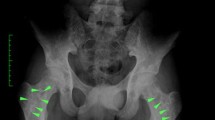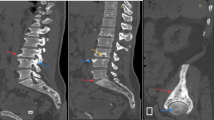Abstract
We describe the palaeopathologic and radiographic findings of the human skeletal remains that belonged to a female who lived in Mexico’s viceroyship period (seventeenth and eighteenth centuries A.D.). Radiographic studies showed numerous, radiodense, ovoid, small and well-defined foci in the long tubular bones, sacrum, scapulae and iliac bones. Computed tomography (CT) examination revealed multiple hyperdense foci located in the central marrow portion of the bones. Measurements of attenuation coefficient revealed +1548 HU. The findings are consistent with osteopoikilosis, an uncommon, benign sclerosing bone dysplasia transmitted in an autosomal dominant fashion, which in the clinical setting is important to set apart from different bone pathologies to avoid unnecessary interventions and treatments. To the best of our knowledge, this is the first report of osteopoikilosis in ancient human remains.




Similar content being viewed by others
References
Appelboom T, Struyven J (1999) Medical imaging of the Peruvian mummy Rascar Capac. Lancet 354:2153–2155
Mansilla J (1997) Indicadores de respuesta al estrés (agresiones ambientales) en la colección osteológica del templo de San Jerónimo, Ciudad de México. Universidad Nacional Autónoma de México
Ubelaker DH (1989) Human skeletal remains. Excavation, analysis and interpretation. Taraxacum 2989, Washington, USA
Ferembach D, Schwidetzky I, Stloukal M (1979) Recommendations pour determiner l’age et le sexe sur le squelette. Bull Mem Soc d’Antrhrop Paris 6:7–45
Mansilla J, Pijoán C, Pompa JA, Villegas D (1992) Los entierros primarios del templo de San Jerónimo, Ciudad de México (temporada 1976). Estudio de los indicadores de las agresiones ambientales. Anuario de Antropología Física 1991. Instituto Nacional de Antropología e Historia 121–149
Benli IT, Akalin S, Boysan E, Mumcu EF, Ku M, Turkoglu D (1992) Epidemiological, clinical and radiological aspects of osteopoikilosis. J Bone Joint Surg Br 74:504–506
Walker GF (1964) Mixed sclerosing bone dystrophies. Two case reports. J Bone Joint Surg Br 46:546
Allen DC, Grenon H (2002) The association of Buschke-Ollendorf syndrome and nail-patella syndrome. J Am Acad Dermatol 46:621–625
McLennan MK (1999) Radiology rounds. Can Fam Physician 45:2315–2320
Busch KFB (1937) Familiar disseminated osteosclerosis. Acta Radiol 18:693
Berlin R, Hedensiö B, Lilja B et al (1967) Osteopoikilosis: a clinical and genetic study. Acta Med Scand 18:305–314
Bethge JFJ, Ridderbusch KE (1967) Über Osteopoikilie und das neue Krankheitsbild Hyperostose bei Osteopoikilie. Ergeb Chir Orthop 49:138
Weisz GM (1982) Lumbar spine canal stenosis in osteopoikilosis. Orthop Clin 166:89–92
Sarralde A, García-Cruz D, Nazara A, Sánchez-Corona J (1994) Osteopoikilosis: report of a familiar case. Genet Counsel 5:373–375
Borman P, Ozoran K, Aydog S, Coskun S (2002) Osteopoikilosis: report of a clinical case and review of the literature. Joint Bone Spine 69:230–233
Raskin MM (1975) Osteopoikilosis: possible association with dystocia and keloid. South Med J 68:270–278
Resnick D, Niwayama G (1995) Enostosis, hyperostosis and periostitis. In: Resnick D (ed) Diagnosis of bone and joint disorders, vol 6, 3rd edn. WB Saunders, Philadelphia, pp 4404–4411
Chigira M, Kato K, Mashio K et al (1991) Symmetry of bone lesions in osteopoikilosis. Report of 4 cases. Acta Orthop Scand 62:495
Dehan S, Bonafe JL, Laroche M, Rousseau H, Railhac JJ (1989) Iconography of Buschke-Ollendorf: X-ray computed tomography and nuclear magnetic resonance of osteopoikilosis. Ann Dermatol Venereol 116:225–230
Whyte MP, Murphy WA, Seigel BA (1978) 99mTc-pyrophosphate bone imaging in osteopoikilosis, osteopathia striata, and melorheostosis. Radiology 127:439–443
Tong ECK, Samii M, Tchang F (1988) Bone imaging as an aid for the diagnosis of osteopoikilosis. Clin Nucl Med 13:816–819
Jaffe HL (1972) Metabolic, degenerative and inflammatory diseases of bones and joints. Lea and Febiger, Philadelphia
Lagier R, Mbakop A, Bigler A (1984) Osteopoikilosis: a radiological and pathological study. Skeletal Radiol 11:161–168
Lagier R, Kramar C, Baud CA (1989) Multiple bone islands in a skeleton dating from the Neolithic period. Eur J Radiol 9:81–82
Author information
Authors and Affiliations
Corresponding author
Rights and permissions
About this article
Cite this article
Amezcua-Guerra, L.M., Mansilla-Lory, J., Fernández-Tapia, S. et al. Osteopoikilosis in an ancient skeleton: more than a medical curiosity. Clin Rheumatol 24, 502–506 (2005). https://doi.org/10.1007/s10067-004-1072-7
Received:
Accepted:
Published:
Issue Date:
DOI: https://doi.org/10.1007/s10067-004-1072-7




